Menus
- The Yamaha GT Sport passes the 6th and is released, finally
- Fifth generation of the name, the Sport GT of the firm with tuning forks returns to the market in a livery more accomplished, more sophisticated, more elaborate..
- Story
- Discovery
- Technical
- In the saddle
- In the city
- Motorway and expressways
- On departmental road
- Braking
- Consumption
- Convenient
- Conclusion
- New features of the FJR1300AE / AS
The Yamaha GT Sport passes the 6th and is released, finally
Fifth generation of the name, the Sport GT of the firm with tuning forks returns to the market in a livery more accomplished, more sophisticated, more elaborate..
Marketed this February in France in two versions, AE (with electronic suspensions) and AS (semi-automatic gearbox), the 2016 FJR 1300 vintage is now equipped with a new flexible anti-dribble clutch for a smooth downshift, a complete pack of adaptive LED lighting in the bends (excuse the little) and a new anti-glare dashboard requested by the customers of this sporty road.
The integration of the Euro 4 standard frees this FJR 1300 from the shackles of 100 horsepower to allow it to offer a free version of 146 horsepower. And finally, the icing on the cake, this 2016 version finally sees the long-awaited and longed-for arrival of a 6th gear. An integration that required Yamaha engineers to completely redefine the entire low engine.
As a result, we will see during this test, the FJR 1300 turns into a high-performance motorcycle, more dynamic, still as comfortable and finally more "creamy"..
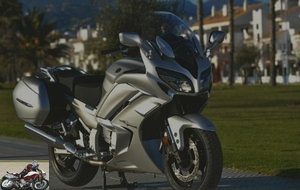
Story
So nothing to do with the 1st generation FJR from 2001. With this 1st model Yamaha had found a way to launch on the market a GT-Sport compromise equipped with a cardan shaft and above all an aluminum chassis supposed to provide rigidity and lightness. Generation 2 of the FJR in 2003 was supplemented, in terms of safety, by an ABS option and, from an aesthetic point of view, by the integration of its indicators. We then had to wait until 2006 and the 3rd generation to see the arrival of a new design, a draft of today’s and of a new chassis. It is especially in this year that we will witness on the one hand the appearance on this model of a unified front and rear braking system and on the other hand the marketing of two versions, an A version " normal ”and an AS version incorporating an avant-garde electronically controlled motorized gearbox system (YCC-S). A version easily identifiable by the absence of a clutch lever. The gear change is done only at the foot or with the help of triggers placed at the level of the left handle.
At the end of 2013, Yamaha then presented its 4th generation with once again a revised chassis and engine but also more sophisticated on-board electronics including traction control and cruise control. Another innovation, but only on the AS version, where the Japanese manufacturer made the choice of an inverted fork accompanied by an electronic device of piloted suspensions, a system thus offering, better than the Kâma-Sûtra, a panel of 83 positions ….
Four generations which have enabled Yamaha to sell no less than 100,000 models worldwide, including 60,000 in Europe. From 2001 to 2015, some 20,000 FJR 1300 found takers in France, a fifth of which, it is true, from the police (police, gendarmerie and customs).
The arrival of this 5th generation 2016, agile and fun, dynamic and efficient, equipped but not too sophisticated, at a low price (all integrated options) compared to the competition could allow Yamaha to consolidate its 2nd place in terms of sales on this segment and why not get closer to its German competitor.
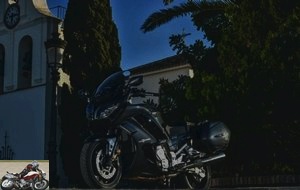
Discovery
At first glance this 2016 version FJR 1300 has hardly changed. Whether in its dark and discreet livery (Tech Graphite) or in its light gray dress (Matt Silver), it keeps its imposing and accessible side at the same time. Long and slender, seen in profile, the callipygous rump, a bit fellinian from its suitcases, seen from the rear, ready to comfortably accommodate its passenger. We end the tour of the “owner” fascinated by his bichehb gaze. Its two optics similar to eyes surmounted by a row of LEDs like makeup eyelids ready to wink in each turn, we will come back to this later..
Draped in a mature and refined set, with rather discreet tuning forks on its tank and subtle reminders of the brand on its sides, this road keeps an undeniable sporty aspect, in short a sporty, elegant, muscular and at the same time refined..
Technical
From a technical point of view, we will first of all look at the new gearbox of this 2016 FJR, a obviously good gearbox …. in all respects.
Redesigned for this 5th generation version, this FJR is the first Yamaha to adopt a 6-speed transmission with redesigned helical gears. This transformation not only makes the gearbox compact compared to the conventional transmission fitted with spur gears, but also saves weight. A gain of around 400g compared to the 5-speed unit. A new gearbox which will thus make better use of the high torque of the 1298cc engine. A 6th gear that will ultimately be used little in the context of this test in the rain, except on the fast sections as well as on the motorway.
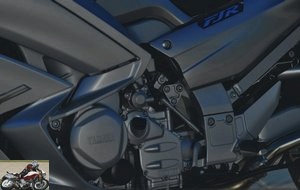
Another not insignificant technological innovation on this 2016 version, a new flexible assisted anti-slipping clutch (A&S) whose design is similar to that of the YZF-R1 2015. For fans of technique, know that this anti-dribble clutch uses an inclined cam between the clutch housing and pressure plate. This new slanted cam structure increases the force of the smaller caliber clutch springs, making the clutch lever lighter. Result and this is what we will remember in the context of this test, this new clutch requires less effort on the part of the driver and above all it offers a smooth downshift which will not be negligible when approaching bends. on wet and therefore slippery roads.
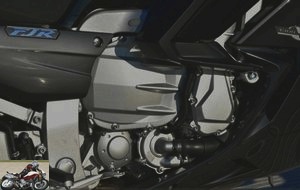
We will now focus, in this technical part, on the brand new LED lighting of this FJR. In order to consolidate the position of its sporty roadster, Yamaha has therefore chosen to equip its 2016 vintage with a new dual-optic headlight incorporating the latest LED technology. Innovation also found at the rear on the new light combination which is slightly wider than on previous models. And so the set seen from other road users arriving behind consists of a central cluster of LEDs for the brake light surrounded by an outer perimeter of LEDs. It should also be noted in passing that each indicator is made up of three horizontal LEDs. But what is essentially the novelty of this vintage is the arrival for the first time at Yamaha of adaptive lighting both on its AE model as well as on the AS.
This system controlled by the inertial unit (IMU) allows, as the motorcycle tilts in a curve, in a turn, to gradually trigger the three LEDs arranged above the dual-optic headlights. Reflectors positioned between each of the lamps of this adaptive lighting thus project an optimal amount of light illuminating the trajectory of the motorcycle. Clearly and no pun intended, this system, which works both in low beam and high beam, allows you to better see the curves and therefore the trajectory at night avoiding these shadowy areas, which we all know. , generated by a unidirectional headlight.
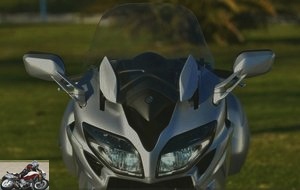
It should also be noted in passing, a plus in terms of safety, that these new 2016 FJRs each benefit from a device, located under the rear seat, allowing the adaptation of Dainese’s D-Air Street system. To benefit from the air bag system with sensors and therefore wireless from the Italian brand, just order and have installed at a D-Air Street distributor the M D-Air kit specially adapted to this FJR 1300. Kit which will be available in during this first trimester.
I won’t dwell on the engine part of this sporty, liquid-cooled inline-four. Only its 146 horsepower finally released thanks to the Euro 4 standard give it this power which it was so lacking in its “restricted” version. We must not forget that the beast, all full facts, still exceeds 290 kg, 292 to be exact. Fortunately, its generous torque now allows strong acceleration, regardless of the gear engaged..
As with the previous generation, this FJR 1300 AE is equipped with an inverted fork and an electronic control allows the suspension system to be adjusted to the driving conditions. The pilot can thus choose with the left thumb one of the four modes, solo, solo with luggage, duet, duet with luggage. The system also offers the ability to tailor damping with "soft", "standard" and "hard" modes – no less than 12 preset suspension settings. Come on, it’s time to get on this GT.
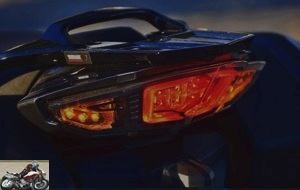
In the saddle
No luck, while the Yamaha France team has chosen the south of Spain as the test site for this FJR1300AE, in this case the region of Malaga and Marbella, normally famous for its sun and well this morning it’s raining. It even rains heavily. But whatever the GT side of this sports car with its electric screen will protect us. A bubble in parentheses that deserves to be more consistent, wider and higher for "rugby" riders, which is fortunately made possible with the range of accessories. Sitting in the high enough saddle (805mm) is a snap. A high saddle, but which in use will not prove to be high enough. A little too much resting on the handlebars and a slightly too pronounced bending of the legs, the high position (825 mm) will immediately find thanks to my meter 80 avoiding any fatigue and nevertheless allowing to put the feet on the ground when stationary.
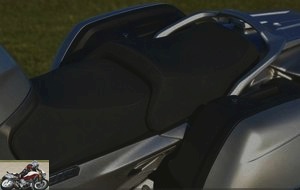
Barely seated on this firm but comfortable saddle, the hands fall easily on the grips (heated) surrounding the saddles of the half-handlebars (also adjustable). In front of you, the new high-tech dashboard with anti-reflective treatment dominated by a cap intended to protect it from the sun, which will not be necessary today…. A dashboard composed of three parts circled in a steel gray finish. On the left, the redesigned tachometer is inspired by those of the R series and gives this road a sporty character. In the center, the digital LCD screen displays the gauge, the time, the mode chosen (touring or sport) and of course the speed. Finally, the right screen displays the rest of the data selected by successive presses on the left stalk. In addition to the gear ratio engaged, it is thus possible to display, via the menu button, the odometer, partial or total, the different temperatures (exterior and engine), consumption while above appear the icons of the menus. …. A few minutes of handling, during the first use, allow you to easily and quickly integrate all the data.
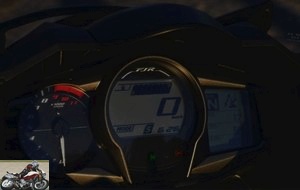
On the left thumb also the button to engage the cruise control while the right thumb will allow him to choose, throttle off, Touring or Sport mode. Last details, the presence of two knobs in front of the dashboard, on each side, allowing the inclination of the optics to be set, and finally the presence, on the left side of a storage compartment containing a 12V socket. Very practical storage compartment that locks itself automatically when the throttle is turned off. All that remains is to lower the FJR from its central stand and exit the parking lot.
In the city
What immediately strikes you is the rather muffled sound of the engine block at first when you turn the key. A sound that immediately becomes more present and more sporty by operating the throttle. The first set in motion, smoothly and quietly, you have to face the cobbled and slippery streets in the rain of the hilltop village of Benalmadena. No problem, the FJR is immediately reassuring. Soft controls, progressive dosage of acceleration, efficient braking without brutality, adapted suspension (which I will all the same reinforce by 2 points, the physique of a retired rugby player requires), it swallows without difficulty or without suddenly the many gendarmes layers. This 2016 model immediately showed its efficiency and at the same time its maturity. Its weight is forgotten, its length too, we are finally surprised by its maneuverability and, to use one of its advertising arguments, its "lightness".
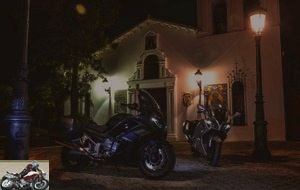
Motorway and expressways
Direction Ronda, the temple of Spanish bullfighting, which can only be reached via a long winding road, ideal, despite the rain, to test this new FJR. But first we will be able to let the 146 horses of this new vintage express themselves on the motorway leading to Malaga. The toll passed, the bust very slightly leaning forward, the hands well supported on the welcoming handlebars, the legs folded up but too much (thank you the high position of the saddle) we will take our cruising speed despite the wet surface . Very quickly the 1298 cm3 changes tone for a rougher sound, more present but absolutely not tiring.
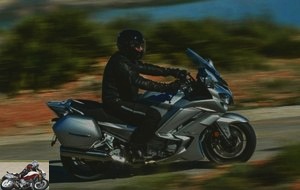
Very quickly the presence of sixth gear will also be felt. Compared to the old "box 5" model, the extension of the first 4 gears then of the 5th will find its culmination in the passage of this 6th where the engine gives the feeling of continuing to breathe with visibly around 500 rpm. less than on previous models. No excessive rigidity, vibrations contained, the bubble raised in the high position, the FJR carves its way on the wet asphalt smoothly and without eddying. The smoothness of the gearbox is immediately felt just like that of the suspensions. This is an opportunity to test your times in overtaking cars and very quickly you realize that you need to drop at least one or even two gears to regain some nervousness. The pickups at low speed of the 6 indeed give the feeling of lacking punch. On the other hand, what tranquility and what comfort once started in this 6th gear, a real cruising speed. On the consumption side, the average indicator will stabilize at 6.4l at 100 to rise to 6.8l by testing the various accelerations in "S" mode. It is also in this sport mode that the "full power" side of this FJR takes on its full significance, allowing for pickups and an extension that the restraint of 100 horsepower did not allow to consider.
On the highway, the GT side of this FJR 1300 takes on its full meaning, length, power and comfort, it is now time to test its sporting qualities..

On departmental road
In ordinary weather, that is to say dry and sunny, the climb to Ronda is a veritable road laboratory, as virulent as you want, to test handling, suspensions, pick-ups and braking. There, given the rain that doesn’t stop, you better have to be careful. That being said, it will also be an opportunity to test the original equipment, the Bridgestone BT 23. More truly in the innovations of the manufacturer, these tires will however be effective and reassuring, showing very good grip in the wet. seconded, it is true, by a sufficiently powerful and reassuring coupled braking. Here again, the easy adjustment of the fork and the rear shock absorber will rise to the occasion, providing a feeling of security.
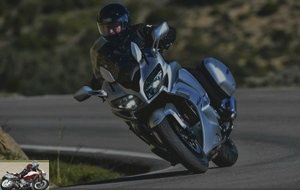
Despite its size and weight, this 2016 FJR will be agile, moving with the tips of the fingers or the knee placed on the 25l tank. Impossible to fully test its ground clearance and so much the better perhaps for its beautiful suitcases, but in any case the passage from one angle to the other is easy, naturally, again smoothly. We can only note its stability on the angle, the efficiency of these pick-ups and suddenly the judicious and timely intervention of the Traction Control requested once on the occasion of a re-acceleration which may be too optimistic. One thing is certain, this FJR knows how to play well with its overweight and shows an agility which one might doubt at first glance. Finally, let’s add the very appreciable role of its new anti-dribble clutch, which at no time has caused jerks or caused slight slips in sometimes powerful downshifts from 4th to 3rd or even from 3rd to second.
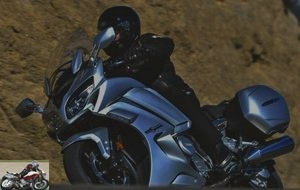
Braking
Effective in all situations and once again taking into account the weight, the ABS and UBS braking system, with two discs (320 mm) at the front and one disc (282 mm) at the rear allows curb the ardor of this FJR. No early intrusion of the ABS system on this tested model either, but it must be recognized that the weather conditions encountered on the day of the test did not allow it to push it to its limits.
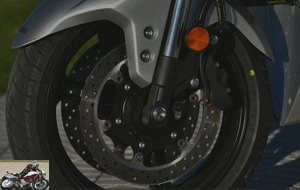
Consumption
It is also difficult to establish precise consumption over only 250 km of testing in once again difficult weather conditions. Let’s say, referring to the on-board computer, that the average rose to 6.4 liters per 100 in constant (and fairly sustained) speed on the motorway, to rise to 6.8 liters in sporty driving.
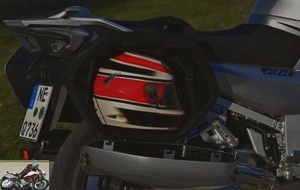
Convenient
The side cases can accommodate a full face helmet on each side.
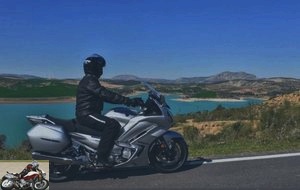
Conclusion
There is no need to say this Sport-GT remains one of the sure values on the market largely optimized by the arrival of a 6th gear. The improvements made to this 5th generation Yamaha FJR, 146 horsepower, 6-speed transmission, flexible anti-slip clutch and adaptive lighting make it a more dynamic sports car, more efficient and a more comfortable and above all safer road. It is difficult to find weak points or to reproach it with the exception perhaps, in terms of protection, of a bubble that is not wide enough and not high enough, an insufficiency that can be easily remedied by the installation of a more substantial screen proposed in the accessories.
Two versions of this 2016 FJR will be offered in French dealerships this month: an AE version, that of this test, equipped with its electronic assistance at a price of € 18,999 and next month (March) an AS version with semi-automatic transmission for € 1,000 more (€ 19,999).
Strong prices certainly but which deserve to be examined closely especially if one takes into account all the included options (electric bubble, heated grips, assisted suspensions….) In the price which is far from being the case by example of its competitor and benchmark of its kind, the BMW 1200RT not to name it.
Strong points
- Power, comfort, softness and smoothness.
- Getting started
- Sport / GT compromise
- Complete and easy adjustments
Weak points
- Original bubble to change depending on the size
- Side stand not always easy to deploy
- Comfortable original saddle but a little hard
The technical sheet of the FJR 1300
New features of the FJR1300AE / AS
- New 6-speed transmission
- Assisted slip clutch (A&S)
- Front headlights equipped with 4 LED lights
- 6 adaptive LED lighting lights (AE / AS versions only)
- LED position lights
- LED turn signals
- Redesigned 3-part dashboard
- Redesigned rear with a combination of LED lights
- Redesigned front fender
- Adapted to the D-Air system
Related articles
-
New re-evolution High-end road symbol of the manufacturer with tuning forks, the FJR 1300 descends from a long line of dynamic travelers. The first of…
-
High-tech cruise missile Since 1983, the K series has been the lineage of benchmark technological innovation for the Munich-based manufacturer. For many,…
-
Test Yamaha XTZ 750 Super Tenere
Twin-cylinder in-line, 749 cm3, 70 hp, 6.8 m / kg, 195 kilos dry, from € 1,000 Produced from 1989 to 1995, this big and reliable road trail smells of…
-
Yamaha Tracer 700 GT motorcycle test
Joys of possibilities Twin-cylinder in-line, 689 cm3, 74.8 hp, 68 Nm, 200 kg all full, available in A2, 8,999 euros. The Yamaha Tracer 700 Gt! Here is a…
-
V-Max without mask Barely out and already cult! However, it is as heavy as an anvil, imposes trajectories worthy of a gondola and its autonomy does not…
-
Evil Torgnole power 10 New sporty troublemaker in the successful Yamaha range, the MT10 sets new standards in terms of four-cylinder mechanics. Its…
-
A high-end and sporty version of Yamaha’s favorite roadster Three cylinders in line, 847 cm3, 115 hp at 10,000 rpm, 8.9 m / kg at 8,500 rpm, 193 kilos, €…
-
The unfinished future The brand with three tuning forks, wishing to prove its lead in terms of technology and innovation, unveiled its 1000 GTS at the…
-
Yamaha Tracer 700 motorcycle test
Sport touring or the modern day SUV Don’t call me trail anymore! Call me sport touring! And here are all the certainties which disappear on all these new…
-
Test Yamaha XT 1200 ZE Super Tenere
E. character slipper XT …, Tenere … some legends can be found in a few signs. In this case, that of Yamaha trails. Driven by the greatest rally…
Hello,
Well tried for a year, but not want to undergo a perhaps hazardous knowledge, or to wipe the plaster of development made by the end customer.
Unfortunately, I learned to my setbacks not to trust blindly. It forces me, but it’s an observation.
Come on, Have a good trip and enjoy it.
You know Tempo, EFI technology dates back to 2008 and when it comes to "wiping plasters", know that they make 600,000 a year. So it’s definitely more proven than a lot of things on the market.
After that, I’m not saying it’s built with the care of an 80s Honda, but still. Motors are super reliable if used correctly…
thank you for following us,
Philippe
Hello
Yes maybe for the EFI, what about the rest? ?
I find the assembly "Indian", in particular the electrical harness whose tape is already peeling off on new machines in the window.
I was excited to see them, because they are really nice these bikes.
Thank you for this test which makes you want.
The recurring question that we legitimately ask ourselves about Royal Enfield is that of reliability.
We can also ask that of the quality of manufacture and finishes, but it seems less important.
Is there indeed a dealer worthy of the name in the western Paris region, who distributes RE, who maintains and who does it properly? The testimonial on the dealerships. of Rambouillet and surroundings is not very encouraging.
We often have this discussion on the SR 400 EFI forum: it is true that as fans of "old" mechanics (neo-retro, dare the word), we are fascinated by the design of these superb REs. . On the other hand, with Yamaha, we are used to flawless reliability … Big dilemma.
As for the pickup at 40 km / h in 4th and 60 km / h in 5th, the SR 400 EFI (whose cylinder is that of the XT 500) does this very well..
V to all.
Hi everyone,
Owner of a Classic from 2009, in other words one of the first to be produced, I would like to point out that the advertised power of my motorcycle is 27.2 hp and has therefore neither decreased nor increased. The 28 hp announced are the consequence of a rounding of the power to the higher horse which has always been practiced.
For those who have questions about reliability, I currently total 43,000 km without major problems, in harsh conditions (I live in Reunion, therefore mountain roads). It is true that the machine tends to rust in some places, but the sea air, humidity and the fact that she sleeps outside have a lot to do with it..
It actually goes up to 140 meter (ie the maximum speed announced on the manual, a little more than 130), which makes it a poorly efficient machine compared to modern productions, but what importance, especially at home where the maximum speed is of 110 (which it holds very well) and or elsewhere than on the four lanes that go around the island, the configuration of the land (no straight lines, climbs, a lot of traffic) naturally limits the speed.
In the mountains, it’s a motorcycle that goes everywhere to be driven with philosophy.